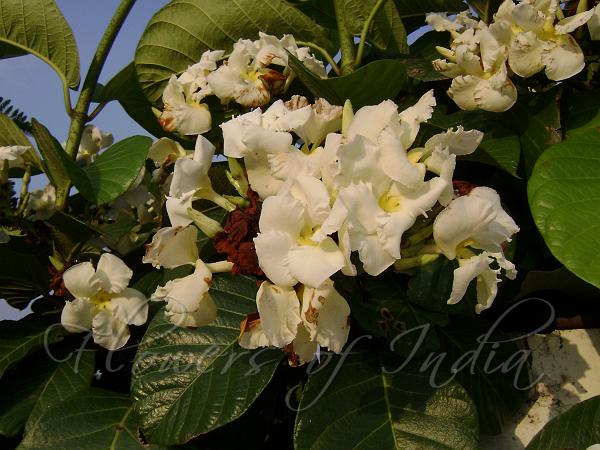|
| Frangipani Vine |
|

|

| File size | 729165 |
| Original date | 6/7/07 5:14 PM |
| Resolution | 3072 x 2048 |
| Flash | Flash did not fire, auto |
| Focal length | 5.8mm |
| Exposure time | 1/320s |
| Aperture | 5.6 |
| Focus Distance | |
| Metering Mode | Multi-segment |
| Camera make | SONY |
| Camera model | DSC-S650 |
| Sensor type |
|
|
|
Photo: Thingnam Girija |
Botanical name: Chonemorpha fragrans Family: Apocynaceae (Oleander family)
Synonyms: Chonemorpha grandiflora, Echites fragrans, Chonemorpha elliptica
Synonyms: Chonemorpha grandiflora, Echites fragrans, Chonemorpha elliptica
Frangipani Vine is a stunning climbing plant,
flowering profusely from May - July. The flowers deceptively resemble the
Frangipani. It is one of the
powerful climbers of the Indian and Malayan forests, climbing to the
tops of the tallest trees. Flowers are pure white with a yellow center,
and have a delicious rich fragrance. Even without the flowers, the vine
is eye-catching with large shiny leaves with prominent veins. It is found
in dense mountain forests, often clinging to trees, in the Himalayas,
from Kumaun to NE India, Andaman isles and SE Asia, and also Western Ghats,
at altitudes of 400-1800 m. Flowering May-July.
Medicinal uses: The leaves, roots, bark-stem
are used in Ayurvedic system of medicines. Leaves are used in the form
of churna/extract or in combination with the other plant materials in
their formulation. It is administered orally. In folk medicine, Murva is used in diseases like anaemia, fever, diabetes, stomach disorders, typhoid,
urinary infections and cough. It is also used in the treatment of
diarrhea, polyuria, boils, leprosy, eye diseases, vomiting
and poisoning.
The leaves, roots, bark-stem
are used in Ayurvedic system of medicines. Leaves are used in the form
of churna/extract or in combination with the other plant materials in
their formulation. It is administered orally. In folk medicine, Murva is used in diseases like anaemia, fever, diabetes, stomach disorders, typhoid,
urinary infections and cough. It is also used in the treatment of
diarrhea, polyuria, boils, leprosy, eye diseases, vomiting
and poisoning.
Medicinal uses:
 The leaves, roots, bark-stem
are used in Ayurvedic system of medicines. Leaves are used in the form
of churna/extract or in combination with the other plant materials in
their formulation. It is administered orally. In folk medicine, Murva is used in diseases like anaemia, fever, diabetes, stomach disorders, typhoid,
urinary infections and cough. It is also used in the treatment of
diarrhea, polyuria, boils, leprosy, eye diseases, vomiting
and poisoning.
The leaves, roots, bark-stem
are used in Ayurvedic system of medicines. Leaves are used in the form
of churna/extract or in combination with the other plant materials in
their formulation. It is administered orally. In folk medicine, Murva is used in diseases like anaemia, fever, diabetes, stomach disorders, typhoid,
urinary infections and cough. It is also used in the treatment of
diarrhea, polyuria, boils, leprosy, eye diseases, vomiting
and poisoning.
| Identification credit: Tabish | Photographed in Imphal, Manipur. |
• Is this flower misidentified? If yes,